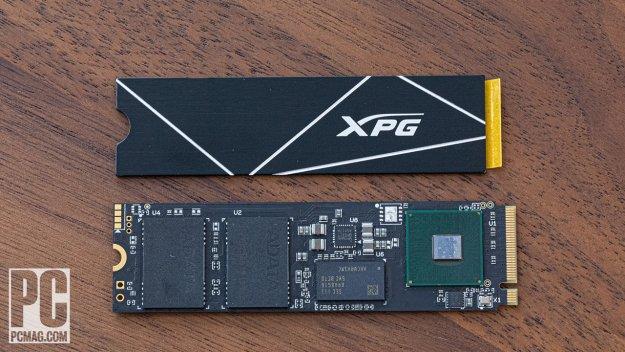The Best SSDs for PS5 in 2022
One compelling feature of the Sony PlayStation 5 is its M.2 slot, which accommodates a second internal solid-state drive to supplement the gaming console's standard SSD. Not just any SSD will do, however—you need a drive that meets Sony's exacting standards for interface, thickness, speed, and more.
Fortunately, many of today's PCI Express 4.0 NVMe SSDs qualify as PS5-compatible, even some that aren't expressly marketed as such. Installing the secondary stick may take a bit of work, but it will let you keep a much larger game library on hand. Here's what you need to know.
How Much Storage Can I Add to My PS5?
The PlayStation 5's built-in SSD has a capacity of 825GB, of which 667GB is free out of the box. Generally, you should be able to fit nine or 10 AAA games on the drive—today's titles on average take 50GB to 60GB of storage, although some are considerably larger. For example, Call of Duty: Black Ops Cold War takes the franchise's trend toward ballooning file sizes to a new high by filling nearly 220GB, so your available space may be gone sooner than you'd think. Fortunately, the PS5 supports secondary drives with capacities ranging from 250GB to a whopping 4TB.
In selecting the drives featured in this roundup, the main requirement was that they meet Sony's official criteria (listed above) for use with a PS5. Most but not all of our choices are marketed by their manufacturers as PS5-friendly. One that isn't, the Samsung SSD 980 Pro, was launched before the PS5 was available, but it easily meets Sony's compatibility specs.
On the other hand, there are a number of M.2 solid-state drives—some touted as PS5-compatible—that fall short in one requirement: their rated data transfer speed or throughput is short of the recommended 5,500MBps. However, this is the only spec for which Sony allows some wiggle room.

An example is the ADATA XPG Atom 50, whose rated sequential read speed is 5,000MBps. Note, too, that as a so-called DRAM-less SSD, the Atom 50's controller lacks the dynamic random access memory cache found in most drives, instead using a bit of your computer's system memory (host memory buffer, abbreviated HMB) as a cache. The PlayStation 5 does not support HMB, a fact that can potentially reduce drive performance. Accordingly, though the Atom 50 will work in a PS5, the ADATA XPG drive we picked for this roundup is the faster, DRAM-equipped S70 Blade.
PS5 Drive Size: How Tall and Long Can a PS5 SSD Be?
For obvious reasons, an SSD's physical height is a critical factor in determining its PS5 compatibility. "Height" in this case is its thickness. Sony recommends that any SSD for the PS5 have a heat dissipation device, a heatsink or heat spreader, which will add to its bulk. But it can be only so big and still fit.
Crucial, for one, markets its P5 Plus SSD as being compatible with the PS5, though that drive ships without a heatsink; the company sells a compatible add-on that should fit the console with room to spare.
The secondary drive must fit in the PlayStation's M.2 bay, which allows a total thickness of 11.5mm (up to 8mm from above the board and up to 2.5mm from below it). This eliminates most drives with nonremovable, finned heatsinks, but some manufacturers are developing compact heatsinks and thin heat spreaders for use in confined spaces. We particularly like the thin, nonremovable heatsink included with the WD Black SN850.
As for drive length, the PS5 supports drives from 30mm to 110mm long. In practical fact, all our picks (and indeed most consumer M.2 SSDs) are the Type-2280, or 80mm, length.
The Upgrade: How to Install an SSD in Your PS5
Installing a second SSD in your PlayStation 5 (see our how-to guide) is not difficult. The only tools you'll need are a small (#1) Philips screwdriver and a pair of tweezers.
Your first step is to run a system update. Then you turn off the console's power, add a heatsink or spreader to the SSD if one isn't already in place, and remove the PS5's side panel. (That can be done without tools, but it may require a little muscle and care.)
Next, remove the expansion slot cover and the M.2 screw, seat the new SSD in the expansion slot, insert the spacer as indicated, and screw the drive into place. Then you close the PS5 back up, format the new drive, and you're good to go.
Whether you managed to nab your PS5 for close to its $499.99 list price or paid a big premium for it,plenty of fast, affordable M.2 PCI Express 4.0 solid-state drives are available that that can fit in its secondary slot. And should you be one of those incredibly patient souls who's still waiting for a PS5 price drop, there'll be all the more compatible SSDs to choose from when you finally get your console.
So, Which PS5 SSD Upgrade Should You Buy?
Our key measure, all else being equal on the spec front, is to look at the cost per gigabyte for any drive you are looking at, using the current sale price. SSD prices tend to rise and fall, and it's often possible to score a fair more capacity than you might think if you shop around. A little math can make it easy to compare the relative value of two drives of different capacities if you look at the cost per gigabyte.
Here we've highlighted some of our favorite PlayStation 5-compatible solid-state drives. Since your console has that open M.2 slot, you might as well put it to good use. While SSD prices (unlike those of many other kinds of PC component) are moderate here in early 2022, it's smart to future-proof your PS5 by getting the highest-capacity drive you can afford and loading it with your favorite games. Happy fragging!








